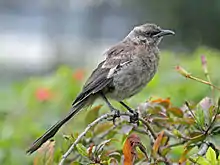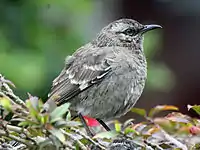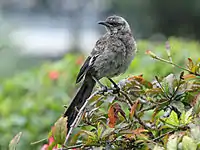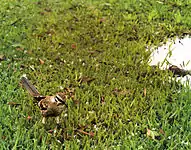Long-tailed mockingbird
The long-tailed mockingbird (Mimus longicaudatus) is a species of bird in the family Mimidae. It is found in dry scrubland and woodland in western Ecuador and Peru (north of Camaná).
| Long-tailed mockingbird | |
|---|---|
 | |
| Scientific classification | |
| Kingdom: | Animalia |
| Phylum: | Chordata |
| Class: | Aves |
| Order: | Passeriformes |
| Family: | Mimidae |
| Genus: | Mimus |
| Species: | M. longicaudatus |
| Binomial name | |
| Mimus longicaudatus Tschudi, 1844 | |
The bird favours open habitats with scattered low bushes and shrubs, such as forest edge and young second growth, montane scrub.[2]
It is frequently found in gardens and parks. It often feeds on the ground, running forwards on relatively long legs.
Description
An attractive, thrush-like bird, the long-tailed mockingbird has a long, elegant tail which it carries at a pert angle whilst on the ground. Its plumage is made up of grey, cappuccino, and dun coloured feathers. The outer tail feathers are broadly tipped white. Its face has been described as harlequin patterned. The juvenile is duller, with a dark iris, and is spotted or streaked on underparts.[2]
Voice
The voice of the long-tailed mockingbird is "a fairly slow-paced series of variable rich whistled notes, churrs, rattles, squawks, and other noises, often with phrases repeated. Calls a throaty "garr!" and rapsing "gaawrr".[2]
Eggs
The eggs are an ovate shape. They are a light blue color, spotted and blotched with different shades of brown and gray. In the study of this nesting site of a Long-tailed Mocking Bird, the eggs were heavily parasitized. Six out of the seven were filled with 2 different species.[3]
Gallery
 Lima, Peru
Lima, Peru Lima, Peru
Lima, Peru Long-tailed Mockingbird at a park in Lima, Peru
Long-tailed Mockingbird at a park in Lima, Peru
References
- BirdLife International (2012). "Mimus longicaudatus". IUCN Red List of Threatened Species. 2012. Retrieved 26 November 2013.CS1 maint: ref=harv (link)
- Thomas S. Schulenberg (2010). Birds of Peru. Princeton University Press. p. 528. ISBN 978-0-691-13023-1.
- Elizabeth J. Mury Meyer.(1981) “The Capture Efficiency of Flickers Preying on Larval Tiger Beetles.” The Auk, vol. 98, no. 1, pp. 189–191. JSTOR, www.jstor.org/stable/4085627. Accessed 6 Mar. 2020.
